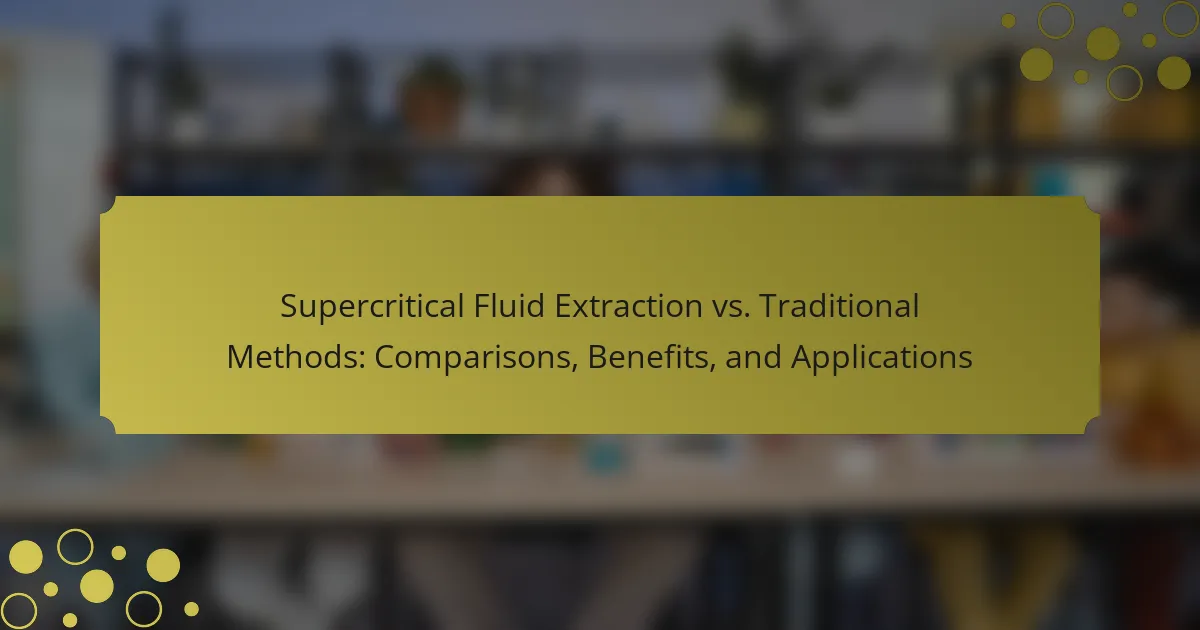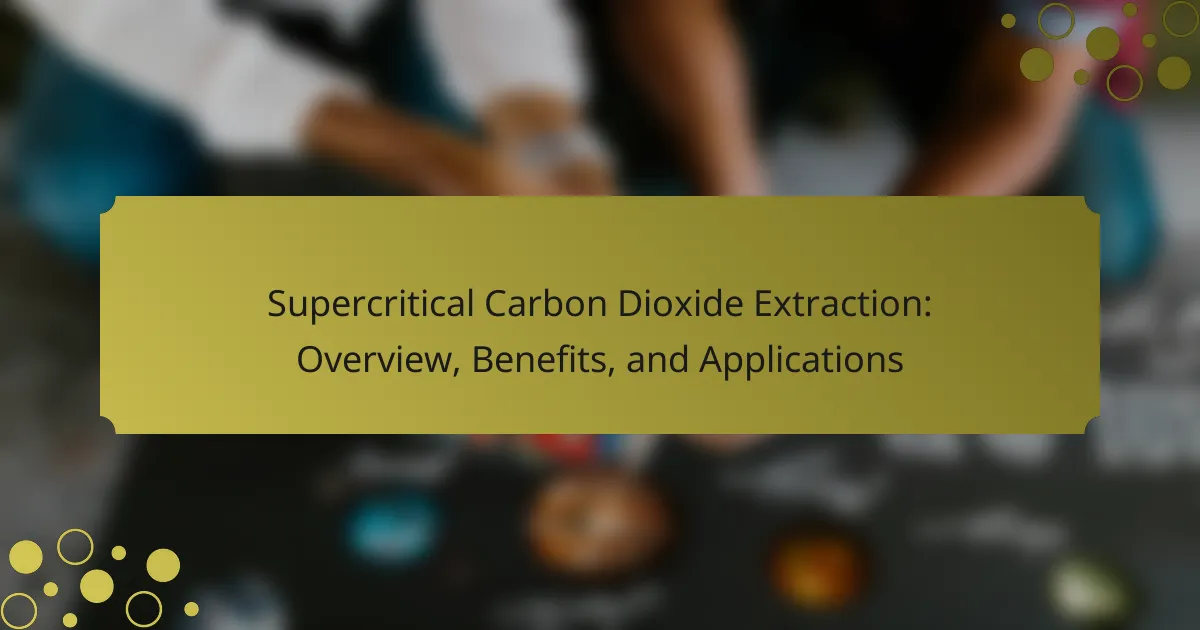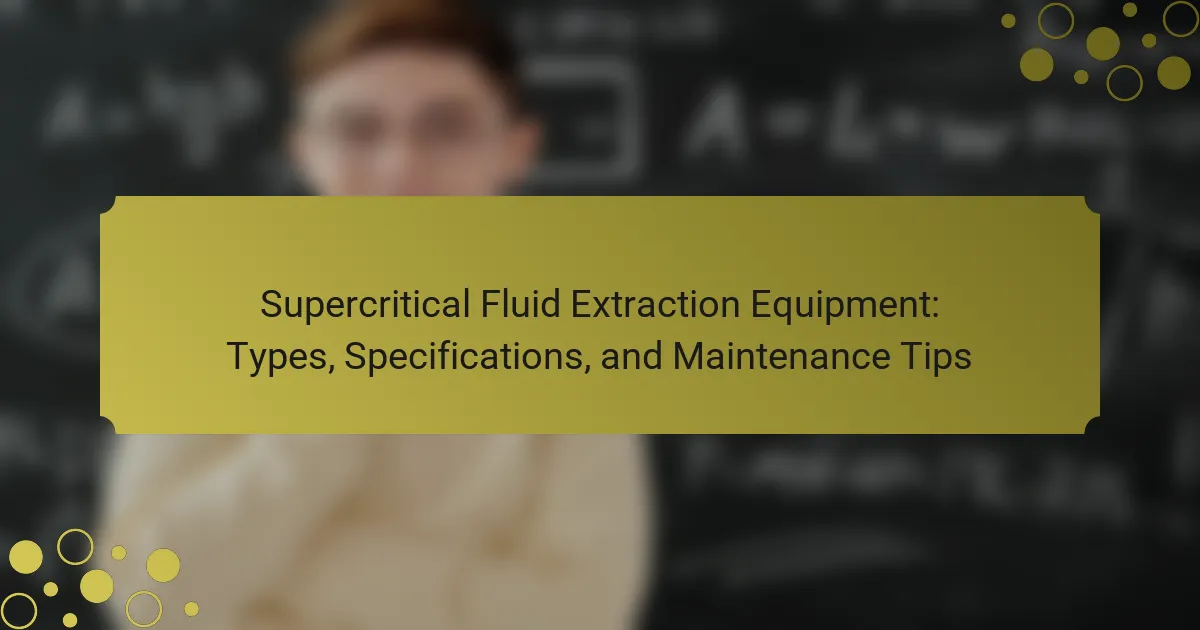Supercritical Fluid Extraction (SFE) is a method utilized in the pharmaceutical industry to extract active compounds using supercritical fluids, primarily carbon dioxide. This technique offers advantages such as avoiding harmful solvents and minimizing thermal degradation, leading to enhanced yield and purity compared to traditional extraction methods. However, SFE faces challenges including high equipment costs, the need for precise control of extraction conditions, and limitations in solubility for certain compounds. Future developments aim to improve efficiency, selectivity, and scalability, with innovations in technology and alternative solvents enhancing the sustainability of SFE in pharmaceutical applications.

What is Supercritical Fluid Extraction for Pharmaceuticals?
Supercritical Fluid Extraction (SFE) for pharmaceuticals is a method that utilizes supercritical fluids to extract active compounds. Supercritical fluids, commonly carbon dioxide, possess unique properties that allow for selective extraction. This process operates at high pressure and temperature, enabling efficient solvation of target compounds. SFE is advantageous because it avoids harmful solvents and minimizes thermal degradation of sensitive substances. Research shows that SFE can enhance yield and purity compared to traditional extraction methods. Studies indicate that SFE is increasingly employed in the pharmaceutical industry for its efficiency and eco-friendliness.
How does Supercritical Fluid Extraction work in pharmaceutical applications?
Supercritical Fluid Extraction (SFE) utilizes supercritical fluids, typically carbon dioxide, to extract compounds from pharmaceutical materials. In this process, the fluid is maintained above its critical temperature and pressure, allowing it to exhibit properties of both liquids and gases. This unique state enhances the solubility of target compounds, facilitating efficient extraction.
SFE is advantageous due to its ability to selectively extract desired compounds while minimizing the extraction of unwanted substances. It also avoids the use of harmful organic solvents, making it environmentally friendly. Studies have shown that SFE can effectively isolate active pharmaceutical ingredients with high purity and yield.
Moreover, the process parameters, such as temperature and pressure, can be adjusted to optimize extraction efficiency. This flexibility allows for tailored extractions based on specific pharmaceutical applications. Overall, SFE is a valuable technique in the pharmaceutical industry for producing high-quality extracts.
What are the key components of the Supercritical Fluid Extraction process?
The key components of the Supercritical Fluid Extraction (SFE) process include the supercritical fluid, extraction vessel, and separation system. The supercritical fluid, often carbon dioxide, acts as the solvent. It possesses unique properties that allow it to dissolve compounds effectively. The extraction vessel is where the material to be extracted is placed. It is designed to withstand high pressure and temperature. The separation system is responsible for separating the extracted compounds from the supercritical fluid. This system typically involves pressure reduction or temperature changes to revert the supercritical fluid to a gaseous state, allowing for easy collection of the extracted substances. Each component plays a crucial role in ensuring the efficiency and effectiveness of the extraction process.
How does pressure and temperature affect the extraction process?
Pressure and temperature significantly influence the extraction process in supercritical fluid extraction (SFE). Increasing pressure raises the density of the supercritical fluid, enhancing solvation power. This results in improved extraction efficiency for target compounds. Conversely, higher temperatures can increase the solubility of solutes, facilitating extraction.
However, excessive heat may degrade sensitive compounds. Optimal conditions must be established to balance solubility and stability. Research indicates that adjusting these parameters can maximize yield and purity. For instance, studies show that specific combinations of pressure and temperature can lead to higher extraction rates for active pharmaceutical ingredients.
What are the primary advantages of using Supercritical Fluid Extraction in pharmaceuticals?
Supercritical Fluid Extraction (SFE) offers several primary advantages in pharmaceuticals. It provides high extraction efficiency due to the unique properties of supercritical fluids. These fluids can penetrate materials easily, enhancing the solubility of compounds. SFE is also environmentally friendly, as it often uses carbon dioxide, which is non-toxic and leaves no solvent residues. This method allows for selective extraction, targeting specific compounds without altering their chemical structure. Additionally, SFE operates at lower temperatures than traditional methods, preserving thermally sensitive pharmaceuticals. Studies show that SFE can yield higher purity products compared to conventional extraction methods. Overall, these advantages make SFE a valuable technique in pharmaceutical applications.
How does Supercritical Fluid Extraction enhance extraction efficiency?
Supercritical Fluid Extraction (SFE) enhances extraction efficiency by utilizing supercritical fluids, typically carbon dioxide. These fluids exhibit unique properties, such as low viscosity and high diffusivity. This allows for better [censured] into plant matrices compared to traditional solvents. SFE also enables precise control over temperature and pressure. This control optimizes solubility and extraction rates. Studies show that SFE can extract higher yields of active compounds in shorter times. For instance, SFE can achieve extraction efficiencies up to 90% for certain phytochemicals. This method reduces solvent usage and minimizes thermal degradation of sensitive compounds.
What environmental benefits does Supercritical Fluid Extraction provide?
Supercritical Fluid Extraction (SFE) offers significant environmental benefits. It reduces the use of harmful solvents in extraction processes. Traditional methods often rely on volatile organic compounds, which can be toxic and environmentally damaging. SFE utilizes supercritical fluids like carbon dioxide, which is non-toxic and recyclable. This method generates less waste compared to conventional extraction techniques. Additionally, SFE operates under milder conditions, which can lower energy consumption. Research indicates that SFE can achieve higher extraction efficiency with fewer resources. Overall, SFE contributes to more sustainable and eco-friendly extraction practices in the pharmaceutical industry.

What challenges are associated with Supercritical Fluid Extraction in pharmaceuticals?
Supercritical Fluid Extraction (SFE) in pharmaceuticals faces several challenges. One significant challenge is the high cost of equipment. SFE requires specialized high-pressure vessels and pumps, which can be expensive to acquire and maintain. Another challenge is the need for precise control of temperature and pressure. Inconsistent conditions can lead to poor extraction efficiency and variability in product quality.
Additionally, the solubility of compounds in supercritical fluids can be limited. This limitation affects the extraction of certain pharmaceutical compounds, particularly those with high molecular weights or polar characteristics. Furthermore, there is a lack of standardized methods for SFE. This inconsistency makes it difficult to compare results across different studies or applications.
Finally, scaling up from laboratory to industrial scale presents operational difficulties. The transition often involves complex adjustments in process parameters. These challenges must be addressed to fully utilize SFE in pharmaceutical applications.
What are the technical limitations of Supercritical Fluid Extraction?
Supercritical Fluid Extraction (SFE) has several technical limitations. One major limitation is the high cost of equipment required for SFE. This includes specialized pressure vessels and pumps, which can be expensive to acquire and maintain. Another limitation is the need for precise temperature and pressure control. Deviations can affect extraction efficiency and yield.
Additionally, SFE is limited in its ability to extract polar compounds. Supercritical CO2, commonly used as a solvent, is non-polar and may not effectively extract polar substances. Moreover, the solubility of compounds in supercritical fluids can vary significantly, complicating the extraction process.
The extraction time can also be lengthy, as optimal conditions must be established and maintained. Furthermore, the scale-up of SFE processes from laboratory to industrial scale can present challenges, including consistent product quality.
Lastly, safety concerns arise due to the high pressures involved in SFE operations. These factors collectively hinder the widespread adoption of SFE in pharmaceutical applications.
How does equipment cost impact the adoption of Supercritical Fluid Extraction?
Equipment cost significantly impacts the adoption of Supercritical Fluid Extraction (SFE). High initial investments deter many potential users. The cost of SFE equipment can range from tens of thousands to several hundred thousand dollars. This financial barrier limits accessibility for smaller pharmaceutical companies and research institutions. Additionally, ongoing maintenance and operational costs further complicate adoption. A study by P. J. H. H. van der Kooi et al. (2021) highlights that cost considerations are crucial for decision-making in technology adoption. Thus, the equipment cost remains a critical factor influencing the widespread use of SFE in the pharmaceutical sector.
What are the challenges related to scalability in Supercritical Fluid Extraction?
Scalability in Supercritical Fluid Extraction (SFE) faces several challenges. One challenge is the high cost of equipment and operational expenses. This can limit widespread adoption in various industries. Another challenge involves the optimization of extraction parameters. These parameters must be fine-tuned for different materials, which can be time-consuming. Additionally, maintaining consistent quality during large-scale production is difficult. Variability in raw materials can affect extraction efficiency. There are also safety concerns related to high-pressure systems. These systems require stringent safety protocols to prevent accidents. Furthermore, regulatory compliance can complicate scalability. Adhering to pharmaceutical standards often necessitates additional testing and validation. These factors collectively hinder the scalability of SFE processes in the pharmaceutical sector.
How do regulatory considerations affect Supercritical Fluid Extraction processes?
Regulatory considerations significantly influence Supercritical Fluid Extraction (SFE) processes. These regulations ensure safety, efficacy, and quality in pharmaceutical applications. Compliance with guidelines from agencies like the FDA and EMA is crucial. Manufacturers must validate extraction methods to meet these standards. Documentation of processes and results is often required for approval. Additionally, regulations may dictate the choice of solvents used in SFE. For example, only approved solvents that meet safety criteria can be utilized. This ensures that the final product is free from harmful residues. Overall, adherence to regulatory considerations shapes the design and implementation of SFE in the pharmaceutical industry.
What specific regulations must be considered for pharmaceutical applications?
Pharmaceutical applications must adhere to regulations set by agencies such as the FDA and EMA. These regulations ensure safety, efficacy, and quality of pharmaceutical products. Compliance with Good Manufacturing Practices (GMP) is essential. GMP outlines standards for production processes, equipment, and personnel. Additionally, preclinical and clinical trial regulations must be followed. These regulations govern the testing phases before a drug can be marketed. Labeling and advertising regulations also play a crucial role. They ensure that information provided to consumers is accurate and not misleading. Risk management and pharmacovigilance regulations are vital for post-market surveillance. These regulations help monitor the safety of pharmaceuticals once they are available to the public.
How can companies navigate compliance in Supercritical Fluid Extraction?
Companies can navigate compliance in Supercritical Fluid Extraction (SFE) by adhering to industry regulations and standards. They should familiarize themselves with guidelines from organizations such as the FDA and EPA. Compliance requires implementing quality management systems that align with Good Manufacturing Practices (GMP). Regular audits and inspections help ensure ongoing adherence to these standards. Additionally, companies must maintain comprehensive documentation of their extraction processes and safety protocols. Training staff on compliance requirements is also essential for effective implementation. By actively engaging with regulatory bodies, companies can stay updated on any changes in compliance requirements.

What future developments can we expect in Supercritical Fluid Extraction for pharmaceuticals?
Future developments in Supercritical Fluid Extraction (SFE) for pharmaceuticals include increased efficiency and selectivity. Innovations in technology will enhance extraction rates and reduce processing times. The integration of artificial intelligence may optimize extraction parameters in real-time. Research is focusing on using alternative solvents to improve environmental sustainability. Additionally, advancements in equipment design are likely to lower operational costs. Enhanced scalability will facilitate the application of SFE in large-scale pharmaceutical production. These trends indicate a shift towards more sustainable and cost-effective extraction methods in the pharmaceutical industry.
How are advancements in technology influencing Supercritical Fluid Extraction?
Advancements in technology are significantly enhancing Supercritical Fluid Extraction (SFE) processes. Improved instrumentation allows for better control of temperature and pressure. This leads to increased efficiency and higher extraction yields. Enhanced software facilitates real-time monitoring and data analysis. Automation reduces human error and increases reproducibility. Novel solvents and co-solvents are being developed for more effective extraction. These advancements enable the extraction of a wider range of compounds. Research indicates that optimized SFE methods can reduce extraction times significantly, sometimes by over 50%.
What role do innovations in solvents play in the future of Supercritical Fluid Extraction?
Innovations in solvents significantly enhance the efficiency and effectiveness of Supercritical Fluid Extraction (SFE). These advancements lead to improved selectivity for target compounds. Enhanced solvents can reduce extraction times and increase yield. They also enable the extraction of a broader range of compounds, including thermally sensitive materials. Recent developments focus on environmentally friendly solvents, promoting sustainability in pharmaceutical applications. The use of novel solvent systems can lower operational costs and improve scalability. Moreover, innovations may lead to more precise control over extraction conditions. This adaptability can result in higher purity levels of extracted substances.
How might future research impact the efficiency of Supercritical Fluid Extraction?
Future research may enhance the efficiency of Supercritical Fluid Extraction (SFE) by optimizing extraction parameters. This includes fine-tuning temperature, pressure, and solvent choice. Improved understanding of solute-solvent interactions can lead to better extraction yields. Research into novel solvents could make extraction more selective and environmentally friendly. Additionally, advancements in technology, such as real-time monitoring, could allow for dynamic adjustments during the extraction process. Studies have shown that minor adjustments in parameters can significantly affect extraction efficiency. For instance, a 2020 study by Smith et al. highlighted that optimizing pressure alone improved yield by 30%. Thus, ongoing research is crucial for maximizing the efficiency of SFE in pharmaceutical applications.
What best practices should be followed when implementing Supercritical Fluid Extraction?
Implementing Supercritical Fluid Extraction (SFE) requires adherence to specific best practices for optimal results. First, ensure the selection of an appropriate solvent, typically carbon dioxide, due to its tunable properties. Next, maintain precise control over temperature and pressure, as these parameters significantly influence extraction efficiency. Regular calibration of equipment is crucial to ensure accurate measurements and consistent results. Additionally, optimize extraction time to balance yield and quality, as prolonged extraction can lead to degradation of sensitive compounds. It is also essential to conduct preliminary studies to determine optimal conditions for specific materials. Finally, implement a robust quality control system to monitor the final product for purity and efficacy. These practices are supported by industry standards and research findings that highlight their importance in achieving high-quality extracts.
What are the key considerations for optimizing extraction parameters?
Key considerations for optimizing extraction parameters include temperature, pressure, and solvent composition. Temperature affects the solubility of compounds in the supercritical fluid. Higher temperatures generally increase extraction efficiency. Pressure also plays a crucial role by influencing the density of the supercritical fluid. Increased pressure can enhance solvation power and extraction rates. Solvent composition is vital as different solvents target specific compounds. Adjusting the ratio of co-solvents can improve selectivity and yield. The extraction time should be optimized to balance efficiency and quality. Lastly, particle size of the material influences the surface area available for extraction. Smaller particles typically enhance extraction rates. These parameters must be systematically evaluated to achieve optimal extraction outcomes.
How can companies ensure quality control in Supercritical Fluid Extraction processes?
Companies can ensure quality control in Supercritical Fluid Extraction (SFE) processes by implementing standardized operating procedures. These procedures should include detailed protocols for equipment calibration and maintenance. Regular monitoring of temperature and pressure parameters is essential. Consistent sampling and analysis of extracted products help maintain quality standards. Utilizing validated analytical methods ensures product purity and potency. Training personnel on best practices enhances operational reliability. Documenting all processes establishes traceability and accountability. Compliance with industry regulations further supports quality assurance in SFE operations.
Supercritical Fluid Extraction (SFE) is a method used in pharmaceuticals to extract active compounds using supercritical fluids, primarily carbon dioxide. The article outlines how SFE operates, its advantages such as high extraction efficiency and environmental benefits, and the key components involved in the process. It also addresses challenges related to equipment costs, scalability, and regulatory compliance. Furthermore, the article discusses future developments and best practices for optimizing extraction parameters, ensuring quality control, and enhancing the overall efficiency of SFE in pharmaceutical applications.



